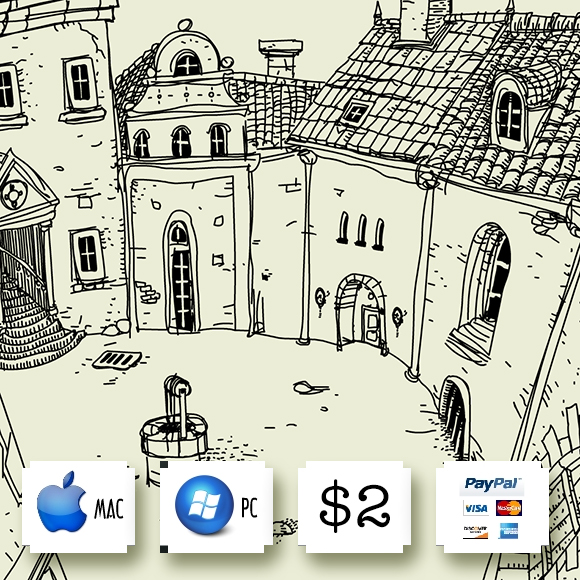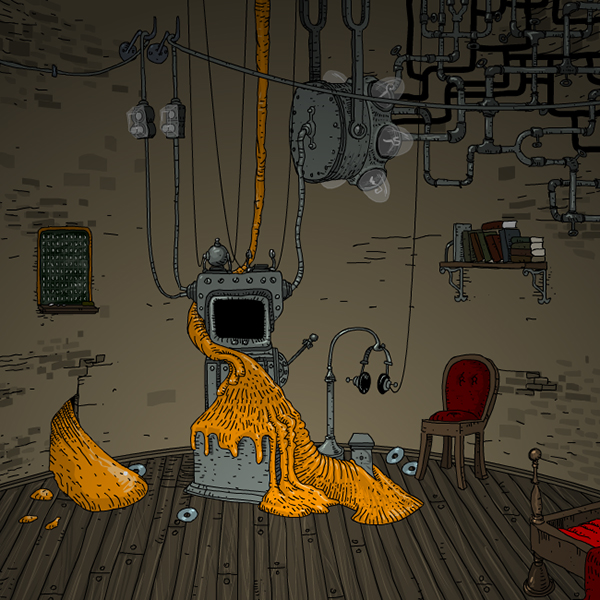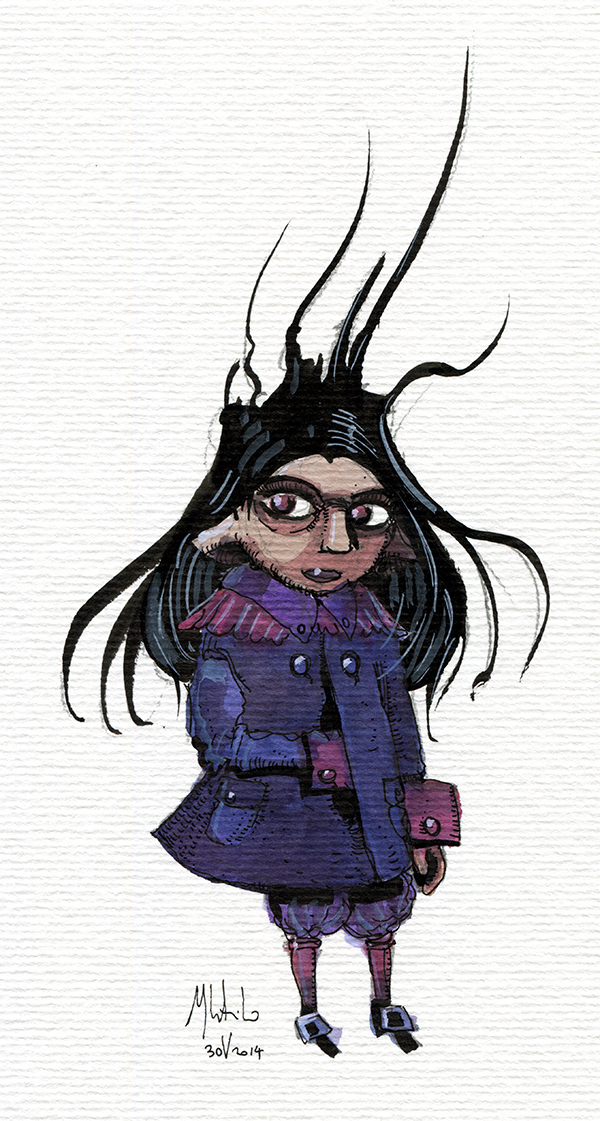Escape from JIG, english walkthrough
June 5, 2014
To complete the game, you have to collect four reptilian limbs and a valve, and then use them all over the main entrance in the room.
Scenes:
Starting scene: The scene you start in. Bed scene: The scene with the stone statue in the bed. Main entrance scene: The scene with a door full of golden sand. Junkyard scene: The scene with old and broken machines.
Limb 1:
Open the lowermost drawer in the bed scene. (Lower left) Get the knife and turn right twice to the junkyard scene. Use the knife in the leftmost coin slot, and get the coin. Turn back to the bed scene, and put the coin in the piggy bank. (Middle left) Get the reptilian limb.
Limb 2:
Grab the floor brush in the lower left of the main entrance scene.
Pick up the transistor in the junkyard scene (on the floor between the two middle machines), and put it on top of the machine in the starting scene. Pull the lever, and wait for the “welcome” sound. Click on the screen and on both green switches to open up two buttons in the starting scene. (upper left) Push the right one of them.
Turn right to the bed scene, and enter the hole in the wall. Use the floor brush on the reptilian limb in the lower right, and click on it to pick it up.
Limb 3:
Push the red book lying on the other books on the bokkshelf in the starting scene. (Upper right) Get the note that falls out.
Zoom in on the chalk board on the left part of the starting scene, and use the note to get a 5-number code. The code changes every time you play.
Limb 4:
In the bed scene, push all red pillows once to reveal a key. Use it on the chest in the upper right of the main entrance scene to get a mahogny eye.
Push the left button in the upper left of the starting scene. (If you can’t push it because it has a cover on it, see “limb 2” to find out about how to open it.)
Turn left to the junkyard scene, and get the mahogny eye from the hole in the wall. Turn left to the main entrance scene.
Put both eyes in the strange statue in the upper left. Get the reptilian limb.
Valve:
In the bed scene, click the valve in the middle right part of the screen 4 times. Turn right, and get the valve from the floor.
Endgame:
Put all 4 limbs by the statue over the door in the main entrance scene. Put the valve in the hole over the door, and click on it to turn it.
Click on the hole in the ground to enter it. Continue going down, and drop down through the hole in the end.
Written by Questioner.
Escape from JIG, Jay Is Games review
I’m not sure if you remember this, but a few months back we asked you guys, “Hey, what are you doing in my kitchen at 3 am eating my Oreos?!!?” Oh wait, that was someone else. We asked you, our illustrious JayIsGames community, tell us what you want, what you really really want… in an escape game that is. And, oh boy, did you answer, all giddy and eager to be locked up again. Not that there was a unified consensus on what should be what, but some repeated refrains did stand out of the chorus. When Littleghost said, “Funny and weird are good,” while JustMe added, “a little creepy, a lot interesting,” a whole bunch of you (Gen, NohWoman, simplynigel, Friar, Shudog, and many others) echoed resoundingly: “Mateusz Skutnik!” You were heard. Escape from Jay Is Games is the result—fan fiction, made by the creator with the players in mind, containing all that wonderful Mateusz vibe, with embellishments from his popular series topping a slice of JayIsGames, and rendered into a single room escape.
Besides being treated to Mateusz Skutnik’s remarkable artwork, his user-friendly and well-tuned interface enhances the thoroughly immersive escaping experience. Click to interact with the environment, navigating the room by clicking the edges of the screen to change angles, dragging objects from the inventory to use on stage or clicking items to view in closer detail. The changing cursor highlights interactive zones to meet the no “wristing-breaking, mouse-mat-burning” pixel hunts criteria requested by rookwings along with the rest of the JIG community. That said, Mateusz’s high quality design makes distinguishing objects worthy of note quite apparent and every detail is so palpable, you’ll want to click everywhere anyhow. Likewise, many of you requested, as did awp81, “logical puzzles that are accessible to all.” Having a game than anyone can play and enjoy is indeed important, and Escape from Jay Is Games is an escape-the-room game in the truest sense, more on scale with Where Is 2014 in terms of difficulty and length. Conversely, if you hold high expectations of epic adventures with labyrinths of rooms, layers of secrets, and cranial-scratching riddles, you face a harder fall into disappointment. Your wish lists are not completely crossed off, yet fortunately that leaves rooms more for future creations and diverts loftier anticipation back toward the next Submachine and Daymare Town installments.
While there’s plenty for fans of those series to recognize, lots of souvenirs of mysteries and mythologies from episodes past, and maybe even winks toward future doings, this is a more humble endeavor in comparison. Although too much narrative would’ve made EFJIG less inclusive, narrowing the possibility of player interpretation, you might also sigh the lack of story beyond a scattered subtext. It’s best to go into it, despite all the ideas you’ve had simmering since the notion was first posed to you, clear of expectation. Then you can take in the unsettling-yet-beautifully surreal scene, heaped with atmosphere and red herrings, without urgency or strain. The art is as striking as ever, giving fans more of what we crave, and it’s remarkable how well some line drawings and color, given a bit of sound and interactivity, can evoke so much mood and enjoyment. Keep the volume on, take your time to explore, smile at allusions, soak in the environment—which Skutnik’s creative imagination leaves us so apt to do—and enjoy what is here. It is truly enjoyable while it lasts. Escape comes quicker than you’d hoped, as both the game’s length and the compelling immersion will likely leave you wanting more and reluctant to leave when the opportunity is given. Come to think of it, I’d better go now, and leave the heftier analysis to you. You know, before I end up like that guy on the bed.
Written by Elle.
Submachine 6 – 9 notes in chinese
地下基地6:邊境
>Pointless (無意義)—(zkelly3)
好吧,看來就是這樣了…
我找不到任何繼續堅持下去的理由。
沒有人會過來的,我一直以來都是個笨蛋。
沒有意義…
>Protocols (協議)—(zkelly3)
不要更改協議。
如果你這麼做的話,他們會把你鎖在裡面的。 我以前曾經看過這種事發生。
這可不是個從這裡消失的好方法。
不管怎麼說,我已經受夠了。
我絕對不會再進去那裏了。
>News flash (新消息)—(cvcv152)
他有沒有跟你說過你不是第一個被送來這裡的人?
那麼,最新消息,我的朋友…
Submachine 1 – 5 notes in chinese
先在這說明遊戲的子機(Submachine)和子網路(Subnet)兩個特殊名詞。
簡單來說Submachine是一個個異次元空間,然後Subnet是Submachine的總稱。
地下基地0:古蹟
>結尾
你獲得了遠古的智慧水晶…
智慧給了你無窮的力量,使你找到了自我的人生道路…
好好利用它吧。
地下基地1
>日記1
去年夏天,我到肯特的大瀑布下露營。這對我來說是一次意義重大的旅行,雖然其他人都不能理解。確實,我是在旅程中失去了左手,但管他的呢,我發現了自己其實擁有第三隻手,一隻隱形的手。自那之後我便開始學習如何運用我的”業力之手”,並很快地將這股力量運用自如。
當人們開始覺得我像是瘋子或怪胎而疏遠我時,我並不感到意外。不過有趣的是,我無法像他們說明真相,這就像是跟一條金魚解釋太空旅行一樣沒有意義。所以我只好試著…
Bart Bonte interview
June 2, 2014
– What first sparked your interest in making your own games?
There came a moment when my computer skills grew sufficient enough to comprehend the then-emerging game building software for noobs and not-really-programmers, meaning – me. The year was 2001 and the software was ‘the Games Factory’. Though it had it’s limitations, I was able to create my first platformers using my own graphics (strangely enough – it was graphics from my comic book “the Morfs” which resemble Daymare Town. So even back then I was kinda going in the right direction). Of course things got a bit more advanced once I was introduced to the Macromedia Flash software. That was in 2003. Still hooked on platform games I discovered website lazylaces.com which was a hub for escape games, unfortunately it’s no longer active. After playing some of those games I thought: “Wait. I can do this better”. And I created Submachine. The rest is history.
– Is making games now your full-time job?
Yes. It’s been this way since 2008, so for more than half of a decade I’m doing nothing but my games to put food on my table. Best half of decade ever.
– Are you autodidact or did you follow art education? Are there other games or game designers that you feel have strongly influenced you?
The closest I got to actual artistic education was studying architecture on technical university. That actually gave me the ability to look at game design from a slightly different perspective. That’s why I call myself games architect. Other than that – no, I never attended any artistic school nor taken any classes or courses. However it took me 15 years to finally learn how to draw so that it doesn’t look like crap. I already knew how to tell comic book stories by then, so it clicked nicely.
– If you had to name one of your games you’re most proud of, which one would it be and why?
I think that would be Submachine 2. It was the largest leap in my game dev advancement. Of course, each game that came after that was more complex and better, but this one marks that moment when my abilities just blew up. My eyes opened back then.
– Do you have an entire series planned out before you create your first chapter or do you continually expand a series?
No, of course not. That would actually be pointless and kind of stupid. You see, when you create a series, new ideas pop up in your head from time to time, and planning ahead would mean disregarding those ideas. We’d loose a big chunk of content and storyline this way. I create my games the same way I create my comic books. Often I start the story and don’t know where I’ll end up with it. Good example would be Daymare Town 4. Through out almost entire development I had a different ending in mind. But the game evolved is such direction that I found a new ending, the one that;s better suited for the situation we were currently in. Normally a player doesn’t see that, but each game is jumping through countless parallel universes, where in each the storyline takes a different turn. My job is to float with it and steer the story in the right direction.
– What was the inspiration for the Submachine series? Would you love to design actual machines?
The works of Amanita (Samorost mainly), Wada Che Nanahiro (Memory Park, Treasure Box, TCB Museum), also Crimson room, Viridian Room and MOTAS. All of them I learned through lazylaces.com. Those were masterful works, I never imagined competing with them. But besides those there were loads of poorly designed and drawn games – that’s where I stepped in. The actual machines? No, I don’t think so. My thing is drawing and telling stories really. Not creating installation art.
– Is submachine 10 going to wrap everything up or is it just going to leave us with more questions?
The tenth Submachine wraps up the main storyline. Which is – us following Murtaugh and Liz through time, space and dimensions. Will it explain everything? I doubt that. That’s almost impossible. If it was to explain all questions then it would be a book, not a game. And that’s why I leave door open for possible submachine standalone games after finishing the main run. Those standalone games would try to answer some burning questions left out from the final game.
– What prompted you to choose the two-color design for the Daymare Town series of games? Is the design process for these games very different/faster than your full color games?
The main idea for the Daymare game was this: how about a game that’s so damn hard – no one will be able to say it’s too easy. How about making it in sketches only. By then I also already knew Nanahiro’s work, and Daymare is kind of derivative from his Treasure Box. Is it faster? No, not at all. On the contrary – when making a color drawing I can just fill some spaces with color and not bother with them anymore, while here – I have to render each surface, each nook and cranny with just lines, shadowing, pores, structure and so on. It’s actually harder and takes longer than, let’s say, creating a submachine view.
– Will we ever see something photography inspired like the 10 gnomes series again? Do you do a lot of photography?
Well, 10 Gnomes are not dead. It’s an ongoing series, since the main project ended in 2008, I’m creating one additional game yearly. Not sure if I’ll be able to keep it up, but for now – it’s going well. Do I do a lot of photography? I don’t think so. Right now everyone with a smartphone is a photographer. It’s nothing uncommon. I am not a photographer, I’m just a dude with a camera.
– Are you planning to bring your games to mobile? Is it helpful when we buy the HD versions of your games?
The mobile market is very unpleasant and unforgiving. When you’re not backed by a large promotional campaign, you’re toast. We learned that the hard way when Pastel Games went mobile in 2008 and in less than a year went belly-up. But – we might try again, this time with a better plan. I can’t really talk about this, but something is brewing. As for HD games – those have literally nothing to do with mobile versions. Buying HD versions is very helpful though. Thanks to those purchases I’m able to live, feed my family and work in peace not bothered by some additional work that I’d have to do for somebody else for profit. I’m self-sustaining entity and that’s something very important to me. The creative freedom that comes with it is priceless. Big THANK YOU goes out to everyone who bought a game from me. Or a comic book. That’s also possible, you know.
– Can we expect more Pastel Games from other artists or are you mainly concentrating on your own games now?
Well, that’s a good question, but addressed to a wrong person. You’d have to ask the creators of respective series. We’re not pushing anybody to work with us and we don’t actually manage those people. Once they do something and it lands on my desk for me to program – then I do it and the game is out. It was always like this, lately those people probably have something more important to do. From what I’ve heard, the Fog Fall 5 is in the works (and has been for the last two years, so there).
– Are you playing a lot of games yourself (web/console/mobile)? What recent games did you enjoy?
Not really. I don’t have a time. Especially since the beginning of 2014 was jam-packed with work (Submachine 9, new comic book, now JayisGames game). I didn’t play anything since January and that saddens me. I have a backlog of games waiting in line for me to play them. They’re even installed on steam, just waiting, updating from time to time…. This line includes second season of the Walking Dead, Metro: Last Light, Hard Reset and lately I added Transistor… The only exception is “the Child of light” – I’m playing that with my daughter in co-op on our PS3.
– What can we expect from you in the (near) future?
In the near future – let’s talk the remainder of 2014. You can expect the entire Submachine series in HD, as well as Daymare Town in HD. That’s plan A. Besides that – probably new Gnomes game and for sure Where is 2015. Besides that – another update to the Submachine Universe (reaching for the 100th location). Comic book wise – I just released a book, but I’ll be making another one this summer. It should be out in October. That’s another book from my Revolutions comic book series. This time it’s entitled “Revolutions under the snow”. That’s all I can say for now. So, busy spring, busy summer and busy autumn. I’ll rest in the winter. No biggie…
by: Bart Bonte
It’s Not Just an Image on a Computer Screen
May 31, 2014
written by Ida Larsen-Ledet
Welcome to the Submachine
An odd welcome. A cubic wooden room with an art-like construction of undeterminable origin on the wall. In the cubic wooden room next door, a vertical pipe with a hole in it. In the room adjacent to that, a grandfather clock without a clock face. Every room you may enter looks the same and contains seemingly arbitrary objects. The only word of welcome or explanation you got was the title menu.
Oh, and there is no exit. Welcome to the Submachine.
« Previous Page — Next Page »











